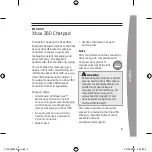
14.3
Operation of the PID Function
14.3.1
Automatic Operation
The PID function can be called as often as every 10 milliseconds by providing power
flow to the Enable input and no power flow to the Manual input. The function block
compares the current CPU time with the last PID solution time stored in the reference
array. If the interval between the two times is equal to or greater than the Sample Period
(word 3 of the reference array) and also equal to or greater than 10 milliseconds, the PID
algorithm is solved using this time interval. Both the last solution time and CV output are
updated. In Automatic mode, the output CV is placed in the Manual Command parameter
(word 14 of the reference array).
Note
If you call the PID block in Auto mode after a long delay, you may want to use
SVC_REQ 16 or SVC_REQ 51 to load the current CPU time into the stored previous
solution time (word 24 of the reference array, described in the previous table). This will
update the last PID solution time and avoid a large step change of the integral term.
14.3.2
Manual Operation
The PID function block is placed in Manual mode by providing power flow to both the
Enable and Manual input contacts. The output CV is set from the Manual Command
parameter. If either the UP or DN inputs have power flow, the Manual Command word is
incremented (UP) or decremented (DN) by one CV count every PID solution. For faster
manual changes of the output CV, it is also possible to add or subtract any CV count value
directly to/from the Manual Command word (word 14 of the reference array).
The PID function block uses the CV Upper Clamp and CV Lower Clamp parameters to
limit the CV output. If a positive Minimum Slew Time (word 12 of the reference array) is
defined, it is used to limit the rate of change of the CV output. If either CV Clamp or the
rate of change limit is exceeded, the value of the integral (reset) term is adjusted so that
CV is at the limit. The anti-resetwindup feature assures that when the error term tries to
drive CV above (or below) the clamps for a long period of time, the CV output will move
off the clamp immediately when the error term changes sufficiently.
This operation, with the Manual Command tracking CV in Automatic mode and setting
CV in Manual mode, provides a bump-less transfer between Automatic and Manual
modes. The CV Upper and Lower Clamps and the Minimum Slew Time always apply to
the CV output in Manual mode and the integral term is always updated. This assures that
when a user rapidly changes the Manual.
Command value in Manual mode, the CV output cannot change any faster than the slew
rate limit set by the Minimum Slew Time, and the CV cannot go above the CV Upper
Clamp limit or below the CV Lower Clamp limit.
282
GFK-1503E
VersaMax PLC User Manual
For public disclosure
Summary of Contents for VersaMax PLC
Page 16: ...Notes 16 GFK 1503E VersaMax PLC User Manual For public disclosure ...
Page 38: ...Notes 38 GFK 1503E VersaMax PLC User Manual For public disclosure ...
Page 50: ...Notes 50 GFK 1503E VersaMax PLC User Manual For public disclosure ...
Page 92: ...Notes 92 GFK 1503E VersaMax PLC User Manual For public disclosure ...
Page 112: ...Notes 112 GFK 1503E VersaMax PLC User Manual For public disclosure ...
Page 224: ...Notes 224 GFK 1503E VersaMax PLC User Manual For public disclosure ...
Page 292: ...Notes 292 GFK 1503E VersaMax PLC User Manual For public disclosure ...
Page 316: ...Notes 316 GFK 1503E VersaMax PLC User Manual For public disclosure ...
Page 317: ......















































